Nikon P7800 vs Panasonic LF1
The Nikon Coolpix P7800 and the Panasonic Lumix DMC-LF1 are two digital cameras that were officially introduced, respectively, in September 2013 and April 2013. Both the P7800 and the LF1 are fixed lens compact cameras that are equipped with a 1/1.7-inch sensor. Both cameras offer a resolution of 12 megapixels.
Below is an overview of the main specs of the two cameras as a starting point for the comparison.

Check P7800 offers at
ebay.com

Check LF1 offers at
ebay.com
Going beyond this snapshot of core features and characteristics, what are the differences between the Nikon Coolpix P7800 and the Panasonic Lumix DMC-LF1? Which one should you buy? Read on to find out how these two cameras compare with respect to their body size, their imaging sensors, their shooting features, their input-output connections, and their reception by expert reviewers.
Body comparison
The side-by-side display below illustrates the physical size and weight of the Nikon P7800 and the Panasonic LF1. The two cameras are presented according to their relative size. Three successive views from the front, the top, and the rear are shown. All size dimensions are rounded to the nearest millimeter.
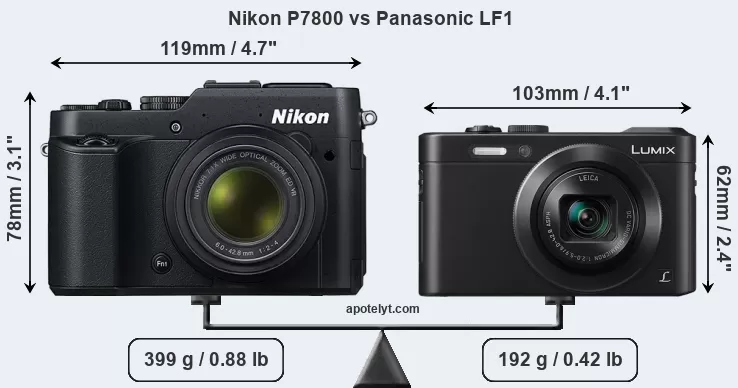
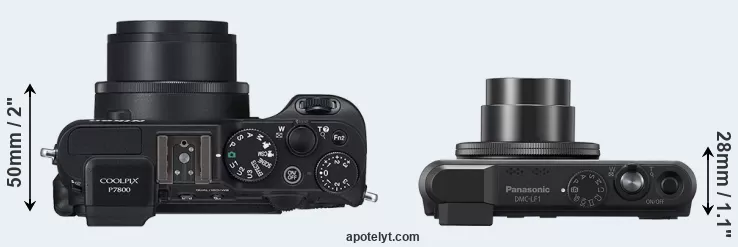
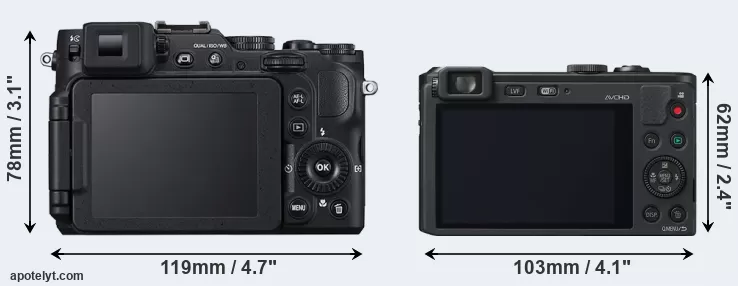
If the front view area (width x height) of the cameras is taken as an aggregate measure of their size, the Panasonic LF1 is considerably smaller (31 percent) than the Nikon P7800. Moreover, the LF1 is substantially lighter (52 percent) than the P7800. In this context, it is worth noting that neither the P7800 nor the LF1 are weather-sealed.
The power pack in the LF1 can be charged via the USB port, which can be very convenient when travelling.
The following table provides a synthesis of the main physical specifications of the two cameras and other similar ones. In case you want to display and compare another camera duo, you can use the CAM-parator app to select your camera combination among a large number of options.

| Camera Model |
Camera Width |
Camera Height |
Camera Depth |
Camera Weight |
Battery Life |
Weather Sealing |
Camera Launch |
Launch Price (USD) |
Street Price |
||
|---|---|---|---|---|---|---|---|---|---|---|---|
| 1. | Nikon P7800 | 119 mm | 78 mm | 50 mm | 399 g | 350 | n | Sep 2013 | 549 | ebay.com | |
| 2. | Panasonic LF1 | 103 mm | 62 mm | 28 mm | 192 g | 250 | n | Apr 2013 | 499 | ebay.com | |
| 3. | Canon G12 | 112 mm | 76 mm | 48 mm | 401 g | 370 | n | Sep 2010 | 499 | ebay.com | |
| 4. | Canon G15 | 107 mm | 76 mm | 40 mm | 352 g | 350 | n | Sep 2012 | 499 | ebay.com | |
| 5. | Canon G16 | 109 mm | 76 mm | 40 mm | 356 g | 360 | n | Aug 2013 | 549 | ebay.com | |
| 6. | Canon S120 | 100 mm | 59 mm | 29 mm | 217 g | 230 | n | Aug 2013 | 449 | ebay.com | |
| 7. | Fujifilm X10 | 117 mm | 70 mm | 57 mm | 350 g | 270 | n | Sep 2011 | 599 | ebay.com | |
| 8. | Fujifilm X20 | 117 mm | 70 mm | 57 mm | 353 g | 270 | n | Jan 2013 | 599 | ebay.com | |
| 9. | Fujifilm X30 | 119 mm | 72 mm | 60 mm | 423 g | 470 | n | Aug 2014 | 599 | ebay.com | |
| 10. | Olympus Stylus 1 | 116 mm | 87 mm | 57 mm | 402 g | 410 | n | Oct 2013 | 699 | ebay.com | |
| 11. | Panasonic FZ200 | 125 mm | 87 mm | 110 mm | 588 g | 540 | n | Jul 2012 | 599 | ebay.com | |
| 12. | Panasonic LX7 | 111 mm | 68 mm | 46 mm | 298 g | 330 | n | Jul 2012 | 499 | ebay.com | |
| 13. | Pentax MX-1 | 122 mm | 61 mm | 51 mm | 391 g | 290 | n | Jan 2013 | 499 | ebay.com | |
| Note: Measurements and pricing do not include easily detachable parts, such as add-on or interchangeable lenses or optional viewfinders. | |||||||||||
The price is, of course, an important factor in any camera decision. The manufacturer’s suggested retail prices give an idea on the placement of the camera in the maker’s lineup and the broader market. The LF1 was somewhat cheaper (by 9 percent) than the P7800 at launch, but both cameras fall into the same price category. Usually, retail prices stay at first close to the launch price, but after several months, discounts become available. Later in the product cycle and, in particular, when the replacement model is about to appear, further discounting and stock clearance sales often push the camera price considerably down.
Sensor comparison
The imaging sensor is at the core of digital cameras and its size is one of the main determining factors of image quality. All other things equal, a large sensor will have larger individual pixel-units that offer better low-light sensitivity, wider dynamic range, and richer color-depth than smaller pixels in a sensor of the same technological generation. Further, a large sensor camera will give the photographer additional creative options when using shallow depth-of-field to isolate a subject from its background. On the downside, larger sensors tend to be more expensive and lead to bigger and heavier cameras and lenses.
Both cameras under consideration feature a 1/1.7-inch sensor and have a format factor (sometimes also referred to as "crop factor") of 4.5. Within the spectrum of camera sensors, this places the review cameras among the smaller-sensor digicams that favor affordability and compact design. Both cameras feature a native aspect ratio (sensor width to sensor height) of 4:3.
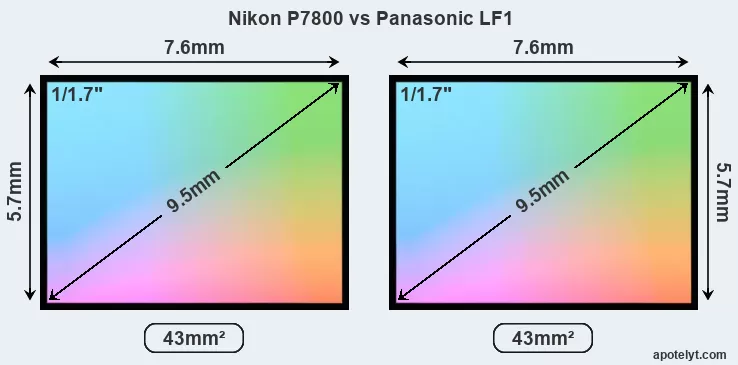
The two cameras under review do not only share the same sensor size, but also offer an identical resolution of 12 megapixels. This similarity in sensor specs implies that both the P7800 and the LF1 have the same pixel density, as well as the same pixel size. It should, however, be noted that the P7800 is a somewhat more recent model (by 4 months) than the LF1, and its sensor might have benefitted from technological advances during this time.
The Nikon Coolpix P7800 has a native sensitivity range from ISO 80 to ISO 3200, which can be extended to ISO 80-6400. The corresponding ISO settings for the Panasonic Lumix DMC-LF1 are ISO 80 to ISO 6400, with the possibility to increase the ISO range to 80-12800.
In terms of underlying technology, the P7800 is build around a BSI-CMOS sensor, while the LF1 uses a CMOS imager. Both cameras use a Bayer filter for capturing RGB colors on a square grid of photosensors. This arrangement is found in most digital cameras.
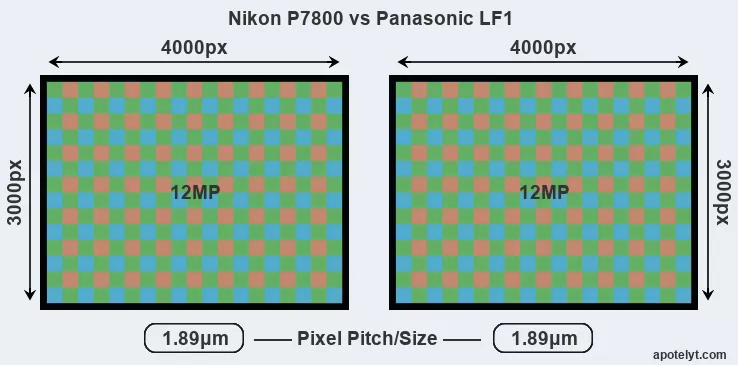
For many cameras, data on sensor performance has been reported by DXO Mark. This service assesses and scores the color depth ("DXO Portrait"), dynamic range ("DXO Landscape"), and low-light sensitivity ("DXO Sports") of camera sensors, and also publishes an overall camera score. The Overall DXO ratings for the two cameras under consideration are close, suggesting that they provide similar imaging performance. The following table provides an overview of the physical sensor characteristics, as well as the sensor quality measurements for a selection of comparators.

| Camera Model |
Sensor Class |
Resolution (MP) |
Horiz. Pixels |
Vert. Pixels |
Video Format |
DXO Portrait |
DXO Landscape |
DXO Sports |
DXO Overall |
||
|---|---|---|---|---|---|---|---|---|---|---|---|
| 1. | Nikon P7800 | 1/1.7 | 12.0 | 4000 | 3000 | 1080/30p | 21.2 | 11.7 | 200 | 54 | |
| 2. | Panasonic LF1 | 1/1.7 | 12.0 | 4000 | 3000 | 1080/60i | 20.8 | 11.6 | 211 | 52 | |
| 3. | Canon G12 | 1/1.7 | 10.0 | 3648 | 2736 | 720/24p | 20.4 | 11.2 | 161 | 47 | |
| 4. | Canon G15 | 1/1.7 | 12.0 | 4000 | 3000 | 1080/24p | 19.9 | 11.5 | 165 | 46 | |
| 5. | Canon G16 | 1/1.7 | 12.0 | 4000 | 3000 | 1080/60p | 21.0 | 11.7 | 230 | 54 | |
| 6. | Canon S120 | 1/1.7 | 12.0 | 4000 | 3000 | 1080/60p | 21.3 | 11.9 | 246 | 56 | |
| 7. | Fujifilm X10 | 2/3 | 12.0 | 4000 | 3000 | 1080/30p | 20.5 | 11.3 | 245 | 50 | |
| 8. | Fujifilm X20 | 2/3 | 12.0 | 4000 | 3000 | 1080/60p | 20.1 | 10.9 | -462 | 46 | |
| 9. | Fujifilm X30 | 2/3 | 12.0 | 4000 | 3000 | 1080/60p | 20.4 | 11.2 | -312 | 49 | |
| 10. | Olympus Stylus 1 | 1/1.7 | 11.8 | 3968 | 2976 | 1080/30p | 20.7 | 11.6 | 179 | 51 | |
| 11. | Panasonic FZ200 | 1/2.3 | 12.0 | 4000 | 3000 | 1080/60p | 19.1 | 10.8 | 114 | 37 | |
| 12. | Panasonic LX7 | 1/1.7 | 10.0 | 3648 | 2736 | 1080/60p | 20.7 | 11.7 | 147 | 50 | |
| 13. | Pentax MX-1 | 1/1.7 | 12.0 | 4000 | 3000 | 1080/30p | 20.4 | 11.3 | 208 | 49 | |
| Note: DXO values in italics represent estimates based on sensor size and age. | |||||||||||
Many modern cameras cannot only take still pictures, but also record videos. The two cameras under consideration both have sensors whose read-out speed is fast enough to capture moving pictures, but the LF1 provides a faster frame rate than the P7800. It can shoot movie footage at 1080/60i, while the Nikon is limited to 1080/30p.
Feature comparison
Apart from body and sensor, cameras can and do differ across a range of features. The two cameras under consideration are similar with respect to both having an electronic viewfinder. However, the one in the P7800 offers a substantially higher resolution than the one in the LF1 (921k vs 200k dots). The table below summarizes some of the other core capabilities of the Nikon P7800 and Panasonic LF1 in connection with corresponding information for a sample of similar cameras.

| Camera Model |
Viewfinder (Type or 000 dots) |
Control Panel (yes/no) |
LCD Specifications (inch/000 dots) |
LCD Attach- ment |
Touch Screen (yes/no) |
Max Shutter Speed * |
Max Shutter Flaps * |
Built-in Flash (yes/no) |
Built-in Image Stab |
||
|---|---|---|---|---|---|---|---|---|---|---|---|
| 1. | Nikon P7800 | 921 | n | 3.0 / 921 | swivel | n | 1/4000s | 8.0/s | Y | Y | |
| 2. | Panasonic LF1 | 200 | n | 3.0 / 920 | fixed | n | 1/4000s | 10.0/s | Y | Y | |
| 3. | Canon G12 | optical | n | 2.8 / 461 | swivel | n | 1/4000s | 1.1/s | Y | Y | |
| 4. | Canon G15 | optical | n | 3.0 / 922 | fixed | n | 1/4000s | 2.1/s | Y | Y | |
| 5. | Canon G16 | optical | n | 3.0 / 922 | fixed | n | 1/4000s | 2.2/s | Y | Y | |
| 6. | Canon S120 | none | n | 3.0 / 922 | fixed | Y | 1/2000s | 12.1/s | Y | Y | |
| 7. | Fujifilm X10 | optical | n | 2.8 / 460 | fixed | n | 1/4000s | 10.0/s | Y | Y | |
| 8. | Fujifilm X20 | optical | n | 2.8 / 460 | fixed | n | 1/4000s | 12.0/s | Y | Y | |
| 9. | Fujifilm X30 | 2360 | n | 3.0 / 920 | tilting | n | 1/4000s | 12.0/s | Y | Y | |
| 10. | Olympus Stylus 1 | 1440 | n | 3.0 / 1040 | tilting | Y | 1/2000s | 7.0/s | Y | Y | |
| 11. | Panasonic FZ200 | 1312 | n | 3.0 / 460 | swivel | n | 1/4000s | 12.0/s | Y | Y | |
| 12. | Panasonic LX7 | optional | n | 3.0 / 920 | fixed | n | 1/4000s | 11.0/s | Y | Y | |
| 13. | Pentax MX-1 | none | n | 3.0 / 920 | tilting | n | 1/8000s | 1.0/s | Y | Y | |
| Note: *) Information refers to the mechanical shutter, unless the camera only has an electronic one. | |||||||||||
The Nikon P7800 has an intervalometer built-in. This enables the photographer to capture time lapse sequences, such as flower blooming, a sunset or moon rise, without purchasing an external camera trigger and related software.
Both the P7800 and the LF1 have zoom lenses built in. The P7800 has a 28-200mm f/2.0-4.0 optic and the LF1 offers a 28-200mm f/2.0-5.9 (focal lengths in full frame equivalent terms). Both cameras offer the same maximum aperture.
Concerning the storage of imaging data, both the P7800 and the LF1 write their files to SDXC cards.
Connectivity comparison
For some imaging applications, the extent to which a camera can communicate with its environment can be an important aspect in the camera decision process. The table below provides an overview of the connectivity of the Nikon Coolpix P7800 and Panasonic Lumix DMC-LF1 and, in particular, the interfaces the cameras (and selected comparators) provide for accessory control and data transfer.

| Camera Model |
Hotshoe Port |
Internal Mic / Speaker |
Microphone Port |
Headphone Port |
HDMI Port |
USB Port |
WiFi Support |
NFC Support |
Bluetooth Support |
||
|---|---|---|---|---|---|---|---|---|---|---|---|
| 1. | Nikon P7800 | Y | stereo / mono | Y | - | mini | 2.0 | - | - | - | |
| 2. | Panasonic LF1 | - | stereo / mono | - | - | mini | 2.0 | Y | Y | - | |
| 3. | Canon G12 | Y | stereo / mono | - | - | mini | 2.0 | - | - | - | |
| 4. | Canon G15 | Y | stereo / mono | - | - | mini | 2.0 | - | - | - | |
| 5. | Canon G16 | Y | stereo / mono | - | - | mini | 2.0 | Y | - | - | |
| 6. | Canon S120 | - | stereo / mono | - | - | mini | 2.0 | Y | - | - | |
| 7. | Fujifilm X10 | Y | stereo / mono | - | - | mini | 2.0 | - | - | - | |
| 8. | Fujifilm X20 | Y | stereo / mono | - | - | micro | 2.0 | - | - | - | |
| 9. | Fujifilm X30 | Y | stereo / mono | - | - | micro | 2.0 | Y | - | - | |
| 10. | Olympus Stylus 1 | Y | stereo / mono | - | - | micro | 2.0 | Y | - | - | |
| 11. | Panasonic FZ200 | Y | stereo / mono | Y | - | mini | 2.0 | - | - | - | |
| 12. | Panasonic LX7 | Y | stereo / mono | - | - | mini | 2.0 | - | - | - | |
| 13. | Pentax MX-1 | - | stereo / mono | - | - | mini | 2.0 | - | - | - |
It is notable that the P7800 has a hotshoe, while the LF1 does not. This socket makes it possible to easily attach optional accessories, such as an external flash gun.
Both the P7800 and the LF1 have been discontinued, but can regularly be found used on ebay. Neither of the two has a direct successor, so they represent the end of the respective camera lines from Nikon and Panasonic. Further information on the features and operation of the P7800 and LF1 can be found, respectively, in the Nikon P7800 Manual (free pdf) or the online Panasonic LF1 Manual.
Review summary
So what conclusions can be drawn? Is the Nikon P7800 better than the Panasonic LF1 or vice versa? The listing below highlights the relative strengths of the two models.

Advantages of the Nikon Coolpix P7800:
- Better sound: Can connect to an external microphone for higher quality sound recording.
- More detailed viewfinder: Has higher resolution electronic viewfinder (921k vs 200k dots).
- More flexible LCD: Has a swivel screen for odd-angle shots in portrait or landscape orientation.
- More selfie-friendly: Has an articulated screen that can be turned to be front-facing.
- Easier time-lapse photography: Has an intervalometer built-in for low frequency shooting.
- Longer lasting: Can take more shots (350 versus 250) on a single battery charge.
- Better lighting: Features a hotshoe and can thus hold and trigger an external flash gun.
- More modern: Is somewhat more recent (announced 4 months after the LF1).

Reasons to prefer the Panasonic Lumix DMC-LF1:
- Better video: Provides higher movie framerates (1080/60i versus 1080/30p).
- Faster burst: Shoots at higher frequency (10 vs 8 flaps/sec) to capture the decisive moment.
- More compact: Is smaller (103x62mm vs 119x78mm) and will fit more readily into a bag.
- Less heavy: Has a lower weight (by 207g or 52 percent) and is thus easier to take along.
- Easier travel charging: Can be conveniently charged via its USB port.
- Easier file upload: Has wifi built in for automatic backup or image transfer to the web.
- Easier device pairing: Supports NFC for fast wireless image transfer over short distances.
- More heavily discounted: Has been on the market for longer (launched in April 2013).
If the number of relative strengths (bullet points above) is taken as a guide, the match-up finishes in a tie (8 points each). However, the relative importance of the various individual camera aspects will vary according to personal preferences and needs, so that you might like to apply corresponding weights to the particular features before making a decision on a new camera. A professional wedding photographer will view the differences between cameras in a way that diverges from the perspective of a travel photog, and a person interested in cityscapes has distinct needs from a macro shooter. Hence, the decision which camera is best and worth buying is often a very personal one.
How about other alternatives? Do the specifications of the Nikon P7800 and the Panasonic LF1 place the cameras among the top in their class? Find out in the latest Best Travel-Zoom Camera and Best Prime Lens Compact Camera listings whether the two cameras rank among the cream of the crop.
In any case, while the comparison of technical specifications can provide a useful overview of the capabilities of different cameras, it remains incomplete and does no justice, for example, to the way the P7800 or the LF1 perform in practice. User reviews, such as those found at amazon, can sometimes inform about these issues, but such feedback is often incomplete, inconsistent, and biased.
Expert reviews
This is why hands-on reviews by experts are important. The following table reports the overall ratings of the cameras as published by some of the major camera review sites (amateurphotographer [AP], cameralabs [CL], digitalcameraworld [DCW], dpreview [DPR], ephotozine [EPZ], photographyblog [PB]). As can be seen, the professional reviewers agree in many cases on the quality of different cameras, but sometimes their assessments diverge, reinforcing the earlier point that a camera decision is often a very personal choice.

| Camera Model |
AP score |
CL score |
DCW score |
DPR score |
EPZ score |
PB score |
Camera Launch |
Launch Price (USD) |
Street Price |
||
|---|---|---|---|---|---|---|---|---|---|---|---|
| 1. | Nikon P7800 | 3/5 | .. | .. | .. | 4/5 | 4.5/5 | Sep 2013 | 549 | ebay.com | |
| 2. | Panasonic LF1 | 3/5 | + | .. | .. | 4/5 | 4.5/5 | Apr 2013 | 499 | ebay.com | |
| 3. | Canon G12 | 4/5 | + | .. | 73/100 | 4.5/5 | 4.5/5 | Sep 2010 | 499 | ebay.com | |
| 4. | Canon G15 | 4/5 | + | .. | 76/100 | 4.5/5 | 4.5/5 | Sep 2012 | 499 | ebay.com | |
| 5. | Canon G16 | 4/5 | + | .. | .. | 4.5/5 | 4.5/5 | Aug 2013 | 549 | ebay.com | |
| 6. | Canon S120 | .. | + + | .. | .. | 4.5/5 | 4.5/5 | Aug 2013 | 449 | ebay.com | |
| 7. | Fujifilm X10 | .. | .. | .. | 76/100 | 4/5 | 4.5/5 | Sep 2011 | 599 | ebay.com | |
| 8. | Fujifilm X20 | 4/5 | + + | .. | 77/100 | 4.5/5 | 5/5 | Jan 2013 | 599 | ebay.com | |
| 9. | Fujifilm X30 | 4/5 | .. | .. | 76/100 | 4.5/5 | 4.5/5 | Aug 2014 | 599 | ebay.com | |
| 10. | Olympus Stylus 1 | .. | + + | .. | .. | 4.5/5 | 4.5/5 | Oct 2013 | 699 | ebay.com | |
| 11. | Panasonic FZ200 | 3/5 | + + | .. | 80/100 | 4.5/5 | 4.5/5 | Jul 2012 | 599 | ebay.com | |
| 12. | Panasonic LX7 | 3/5 | + + | .. | 75/100 | 4/5 | 4.5/5 | Jul 2012 | 499 | ebay.com | |
| 13. | Pentax MX-1 | 3/5 | .. | .. | 74/100 | 4/5 | 4/5 | Jan 2013 | 499 | ebay.com | |
| Note: (+ +) highly recommended; (+) recommended; (o) reviewed; (..) not available. | |||||||||||
The above review scores should be interpreted with care, though. The ratings are only valid when referring to cameras in the same category and of the same age. A score, therefore, has to be seen in close connection to the price and market introduction time of the camera, and comparisons of ratings among very different cameras or across long time periods have little meaning. It should also be noted that some of the review sites have over time altered the way they render their verdicts.

Check P7800 offers at
ebay.com

Check LF1 offers at
ebay.com
Other camera comparisons
Did this review help to inform your camera decision process? If you would like to see a different side-by-side camera review, just use the search menu below. There is also a set of direct links to comparison reviews that other users of the CAM-parator app explored.
- Canon 1200D vs Panasonic LF1
- Canon 1300D vs Panasonic LF1
- Canon 1D Mark IV vs Nikon P7800
- Canon 250D vs Panasonic LF1
- Canon T6i vs Panasonic LF1
- Fujifilm X-Pro2 vs Nikon P7800
- Nikon D5100 vs Nikon P7800
- Nikon P7800 vs Olympus E-30
- Nikon P7800 vs Panasonic FZ1000
- Nikon P7800 vs Sony RX0 II
- Panasonic GX800 vs Panasonic LF1
- Panasonic LF1 vs Ricoh WG-6
Specifications: Nikon P7800 vs Panasonic LF1
Below is a side-by-side comparison of the specs of the two cameras to facilitate a quick review of their differences and common features.
| Camera Model | Nikon P7800 | Panasonic LF1 |
|---|---|---|
| Camera Type | Fixed lens compact camera | Fixed lens compact camera |
| Camera Lens | 28-200mm f/2.0-4.0 | 28-200mm f/2.0-5.9 |
| Launch Date | September 2013 | April 2013 |
| Launch Price | USD 549 | USD 499 |
| Sensor Specs | Nikon P7800 | Panasonic LF1 |
| Sensor Technology | BSI-CMOS | CMOS |
| Sensor Format | 1/1.7" Sensor | 1/1.7" Sensor |
| Sensor Size | 7.6 x 5.7 mm | 7.6 x 5.7 mm |
| Sensor Area | 43.32 mm2 | 43.32 mm2 |
| Sensor Diagonal | 9.5 mm | 9.5 mm |
| Crop Factor | 4.5x | 4.5x |
| Sensor Resolution | 12 Megapixels | 12 Megapixels |
| Image Resolution | 4000 x 3000 pixels | 4000 x 3000 pixels |
| Pixel Pitch | 1.89 μm | 1.89 μm |
| Pixel Density | 27.70 MP/cm2 | 27.70 MP/cm2 |
| Moiré control | Anti-Alias filter | Anti-Alias filter |
| Movie Capability | 1080/30p Video | 1080/60i Video |
| ISO Setting | 80 - 3,200 ISO | 80 - 6,400 ISO |
| ISO Boost | 80 - 6,400 ISO | 80 - 12,800 ISO |
| DXO Sensor Quality (score) | 54 | 52 |
| DXO Color Depth (bits) | 21.2 | 20.8 |
| DXO Dynamic Range (EV) | 11.7 | 11.6 |
| DXO Low Light (ISO) | 200 | 211 |
| Screen Specs | Nikon P7800 | Panasonic LF1 |
| Viewfinder Type | Electronic viewfinder | Electronic viewfinder |
| Viewfinder Field of View | 100% | 100% |
| Viewfinder Resolution | 921k dots | 200k dots |
| LCD Framing | Live View | Live View |
| Rear LCD Size | 3.0inch | 3.0inch |
| LCD Resolution | 921k dots | 920k dots |
| LCD Attachment | Swivel screen | Fixed screen |
| Shooting Specs | Nikon P7800 | Panasonic LF1 |
| Focus System | Contrast-detect AF | Contrast-detect AF |
| Continuous Shooting | 8 shutter flaps/s | 10 shutter flaps/s |
| Time-Lapse Photography | Intervalometer built-in | no Intervalometer |
| Fill Flash | Built-in Flash | Built-in Flash |
| Storage Medium | SDXC cards | SDXC cards |
| Single or Dual Card Slots | Single card slot | Single card slot |
| UHS card support | no | no |
| Connectivity Specs | Nikon P7800 | Panasonic LF1 |
| External Flash | Hotshoe | no Hotshoe |
| USB Connector | USB 2.0 | USB 2.0 |
| HDMI Port | mini HDMI | mini HDMI |
| Microphone Port | External MIC port | no MIC socket |
| Wifi Support | no Wifi | Wifi built-in |
| Near-Field Communication | no NFC | NFC built-in |
| Body Specs | Nikon P7800 | Panasonic LF1 |
| Battery Type | Nikon EN-EL14 | Panasonic DMW-BCN10 |
| Battery Life (CIPA) | 350 shots per charge | 250 shots per charge |
| In-Camera Charging | no USB charging | USB charging |
| Body Dimensions |
119 x 78 x 50 mm (4.7 x 3.1 x 2.0 in) |
103 x 62 x 28 mm (4.1 x 2.4 x 1.1 in) |
| Camera Weight | 399 g (14.1 oz) | 192 g (6.8 oz) |

Check P7800 offers at
ebay.com

Check LF1 offers at
ebay.com
Did you notice an error on this page? If so, please get in touch, so that we can correct the information.

